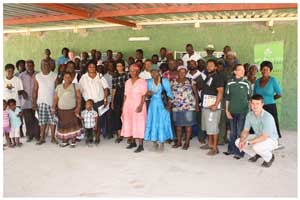
Khorixas farmers want Swakara
Wessel Visser of Agra Professional Services (back row left) and Swakara specialist Jaco van Zyl (front row right) with the Khorixas farmers who are very keen to start Swakara breeding herds.Farmers in the Khorixas district are looking at Karakul sheep with renewed interest for the production of Swakara, the Namibian version of the high-value pelts derived from this sheep originally from Persia, today Iran.
The original Karakul breed has been refined in Namibia to such an extent that it is recognised as a distinct breed, the so-called Swakara, the same name as the internationally famous furs. This sheep holds much promise for boosting agricultural output in the arid zones.
A team of experts from Agra Professional Services presented a Swakara information day earlier in July at Farm Bloemhof, 40 km west of Khorixas, in the Kunene (south) region. The Agra event was organised in cooperation with the local extension services of the Ministry of Agriculture, Water and Forestry (MAWF) in an effort to expose livestock farmers to Swakara pelt production as a viable farming commodity.
Agra said this week the information day exceeded all expectations. It was well-attended by farmers who came to learn about the value of Swakara pelts. Manager of Agra Social Business & Services, Wessel Visser, and Jaco van Zyl, a specialist in Swakara production showed the farmers the many advantages of breeding Swakara. Not only are these sheep the source of the sought-after pelts, they also provide meat, wool and fat and is a useful complement in a mixed farming operation. Visser and van Zyl highlighted Swakara’s value as a multi-purpose breed for arid areas.
Van Zyl said “Swakara sheep hold good potential for diversification. Commonly, day-old lambs are slaughtered for their pelts which relieves the ewes from raising lambs in harsh and dry conditions. If there is enough grazing, lambs can be successfully raised as well. These are usually quality replacement ewes while lambs with poor pelts traits are raised as mutton sheep.”
Pelt and mutton production systems were compared. It was demonstrated that pelt production currently compares favourably to other sheep production on the basis of profitability. Other benefits include lower risk, the sheep’s adaptability to a harsh climate and also the growing demand for this unique Namibian product. However, there are some challenges for instance adult Swakara must be sheared which is costly and labour intensive, while the price for Swakara wool is currently low due to limited demand. Furthermore, quality breeding stock is scarce and expensive. This again prevents many aspiring farmers from joining the industry.
Swakara pelt production is not new to local communal farmers. Back in the sixties, many pelts were produced in these arid areas, suitable for Swakara production. As there is a growing demand for pelts, more Swakara farmers are needed in the industry to fill this gap. “The Swakara industry needs more Swakara farmers to meet the demand for pelts,” said Visser.
The participants expressed their appreciation forAgra’s initiative to empowering them by sharing valuable information. They said they found the presentation enlightening and many of them are motivated to venture into Swakara farming. Furthermore, they requested Agra’s ongoing support to establish the industry in that area.
Agra said as a responsible corporate citizen it will remain committed to develop and improve the Swakara industry. Through the House of Swakara, Agra will continue to focus on the professional marketing of Swakara pelts and wool, developing and implementing strategies for growing the industry, imparting knowledge and directly supporting the farmers in their strive to take the breed to more farming areas.
Swakara is well established as a productive breed with commercial farmers in the South. It has been bred, mostly for its pelts, for over a hundred years.











































